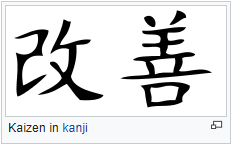For this article I used ideas found in Dr. Robert Maurer's book One Small Step Can Change Your Life: The Kaizen Way.
In one of the companies I managed we held a "Kaizen Event". In such an event, you gather a diverse team of employees in order to carry out targeted improvement. For seven work days the team dedicates all their time to an issue, leading considerable improvement.
Our event focused on changing the production department and increasing efficiency. The team led a radical change in the department, including opening a wall which separated the two parts of the production space. On the third day, Osnat, one of the team members, burst into tears and couldn’t continue. She went home and returned to work only after a week of sick-leave.
Osnat's reaction was extreme, and came from difficulties accepting the change the team led. That change influenced, among other things, her role and her work-station location.
I personally don’t lead such events, but I meet their residues in many companies I work with. I have yet to see long lasting results from a "Kaizen Event". Usually teams reach considerable improvements, but they are only implemented for a short while, a few months at most, and then disappear.
For example, one of the companies I worked with achieved great improvement in the time needed for product set up. But after about a month, graffiti against Kaizen began appearing on the production line, and within a few months there was nothing left of the improvements done.
Why Does Fast and Dramatic Change Scares Us?
In his book One Small Step Can Change Your Life: The Kaizen Way, Dr. Robert Maurer presents the biological explanation to the above question.
He starts by describing the human brain:
At the base of the brain is the brainstem. It's about five hundred million years old, and is referred to as the reptilian brain. It's in charge of basic activities like consciousness, breathing, blood pressure, monitoring body temperature, etc.
On top of the brainstem sits the midbrain, or the mammalian brain. It developed about three hundred million years ago and is found (to a degree) in all mammals.
The last part of the brain is the cortex, the outer brain, which began developing about a hundred million years ago. According to Dr. Maurer, the cortex is in charge of rational thought and creative impulses. When we wish to begin a change or a creative process, we need access to the cortex.
The amygdala is found in the midbrain, and is directly involved in emotional regulation processes and in charge of fear and terror. The amygdala is connected with emotional responses to danger (mainly fear and aggression) and takes part in behavioral, autonomous, and hormonal responses to emotional stimuli.
The "fight or flight" response is associated with the amygdala. One of the ways this happens is by slowing or stopping other functions, like rational and creative thinking, which might damage or delay the physical ability to fight or flee.
In his book, Dr. Maurer claims that the "fight or flight" response is a logical one. When faced with an attack, the brain doesn't need to waste time on intellectual or cerebral focus on the details. As long as humans faced daily dangers in the wild, it was a necessary mechanism.
But today it's a problem, because it sets off "alarm-bells" whenever we deviate from our safe and familiar routines. The amygdala preppers for danger, and limits access to the cortex.
I assume such a situation is personally familiar to you – fear of change, anxiety before important tests, stage fright, and the like. "Fear" has become "stress", but the emotion stayed the same. Certain situations paralyze us.
How to Handle the Paralysis Resulting from Fear or Stress?
Yehudit is a very talented woman and advanced well in her career. But, after she had to leave her job due to personal circumstances, she couldn’t find a new one. Yehudit told me that when she goes to a job interview her brain shuts off and she can't think at all.
Even in a simulation we did she couldn’t speak, became confused, and tears flooded her eyes. I suggested she write down what she wants to say, and when entering the interview, say she's a little stressed and so she wrote down a few key points. Her brave honesty will elicit sympathy, I thought.
And that is indeed what happened. She received very positive feedback after her first interview and in less than a month had a good new job, and with better pay than she had in her previous job.
Knowing she had a note with her main points in her pockets gave her confidence, which "triumphed over" the amygdala. That is, the amygdala didn’t paralyze the cortex.
Dr. Maurer writes that small steps succeed in creating change without "alerting" the amygdala to block the cortex. Our brain is programmed to resist change, but by making small steps we can rewire the neural network in a way which enables us to get around creative blocks and the "fight or flight" response, and engages the whole brain in the process of change.
Why Do Small Steps Work?
Dr. Maurer writes that even positive changes can be scary. Attempting drastic or revolutionary action can be doomed to failure because it enhances our fearful response, while taking small steps can neutralize it. This enables rational thought and creativity.
Often, CEOs working with me wish to lead quick changes because the company is in a state necessitating fast turn-around.
I always present several tools, such as improvement teams, creating employee investment, encouraging efficiency, worker appreciation, and more. But they keep asking for "something fast". But the small steps I suggests are the quickest, they don’t cause resistance, they create employee investment in company goals, and most importantly change the company culture.
What's the Difference Between a "Kaizen Event" and Kaizen?
Now it's easier to understand why "Kaizen Events" cause stress and resistance. In fact, those events are the opposite of Kaizen.
According to Dr. Maurer, Kaizen, alongside innovation, is one of the main strategies used to create change. While innovation is all about dramatic and radical actions, Kaizen works through small and easy steps.
Kaizen Was Born in the USA and Migrated to Japan
Soon after entering WWII, the US government realized they must urgently increase the manufacturing of military equipment, as US soldiers faced being sent overseas. The government initiated management courses called "Training Within Industry" (TWI).
In a course for continual improvement, managers were encouraged to come up with hundreds of small things to improve, instead of looking for big steps.
After the end of the war, the American general Douglas MacArthur, who was in charge of the American Occupation of Japan, realized the importance of Japan as an ally and worked to rehabilitate its economy and industries. He brought to Japan the experts who led the TWI courses. Including those who emphasized the importance of small daily steps.
Thousands of Japanese executives studied and implemented the new methods, while in the US they were abandoned once soldiers returned home and normal life resumed.
The small steps method was so successful, the Japanese gave it their own name: Kaizen, meaning "perpetual improvement".

Who Is Dr. Robert Maurer?
Maurer is an associate professor in the UCLA medical school, an advisor of behavioral health in the Canyon Ranch resort in Tucson, Arizona, and runs a consultancy firm called "The Science of Excellence".
Summary
In this article I presented the source of our resistance to change. Changes stress us and at times our brain becomes blocked and we forget everything we thought before or meant to say.
The best way to overcome resistance and stress is working in small steps. Often this way of small steps is also the quickest one. Both personally and for the company.
If you want to create a fast change or improvement, the quickest and safest way is the small steps method.
Examples of small steps: improvement teams, worker appreciation, encouraging efficiency.
If you are interested in my professional help, personally or for your company, the best way is to send a request through the Get in Touch form in my website (here).












 My First Book: Manage! Best Value Practices for Effective Management
My First Book: Manage! Best Value Practices for Effective Management